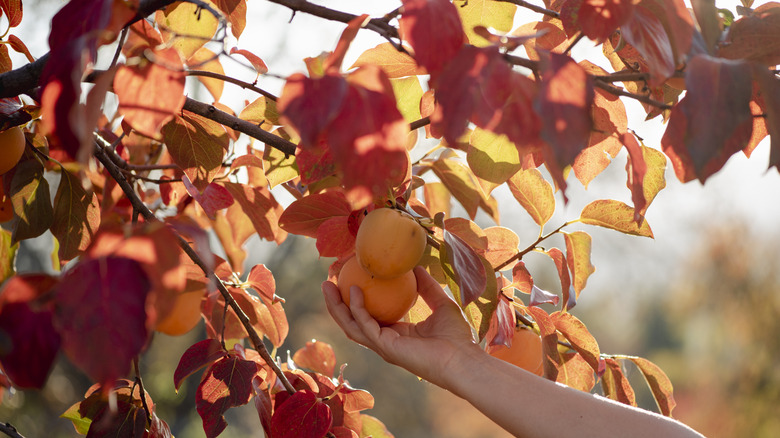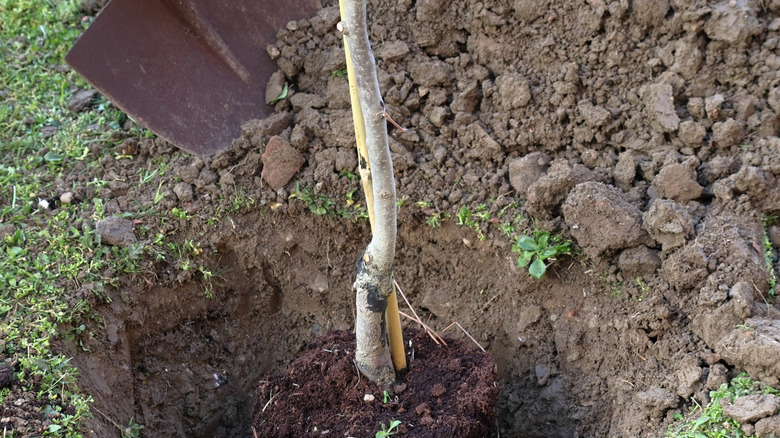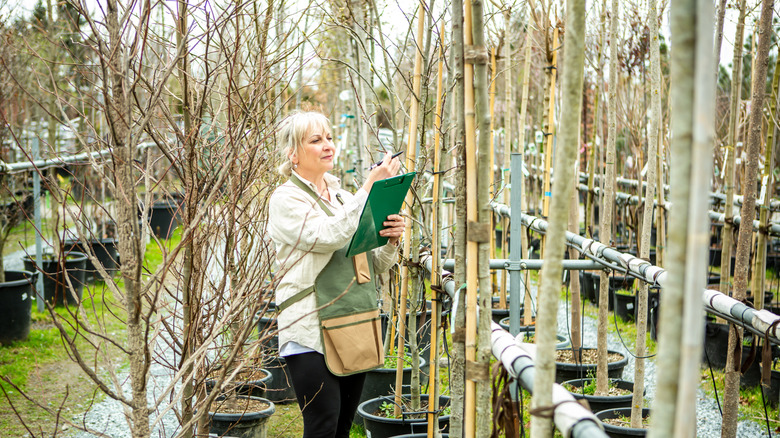The Biggest Problem With Persimmon Fruit Trees (Yes, Even The Grafted Ones)
The American persimmon (Diospyros virginiana) tree is a great addition to an edible landscape. Its fall colors and long-lasting fruit add tons of ornamental value. Because the fruit is best eaten when over-ripe (when it's almost the texture of pudding), it can stay on the tree even after your first frost, extending your harvest season into winter. It's also incredibly hardy, adapts to a wide variety of light and soil conditions, and resists serious damage from most common pests and diseases. But if you're looking for fast-growing fruit trees that will start bearing fruit within a year or two of planting, the persimmon tree might not be it.
The American persimmon won't start bearing fruit until it's at least four years old when grown from seed. Even then, your tree might not reach full production until around 10 years. Moreover, it's dioecious, which means its male and female reproductive parts grow on separate trees. So, if you only have one tree, you won't see fruit no matter how long you wait.
Whether you don't have room to plant more than one fruit tree or you don't want to wait four or more years to harvest fruit, there are a few tricks you can use to speed up the growth and fruit production from your persimmon trees. There are also some guidelines you can use while shopping for persimmon or other fruit trees to help you choose a plant that's likely to start producing faster.
Tricks to speed up persimmon fruit production
While American persimmons are slow to fruit when grown from seed, there are some tricks to help your fruit trees grow and produce faster. The most common workaround is to buy grafted trees. Grafted trees are made up of a cutting from a mature tree that's been attached to the rootstock of another tree. There are a few reasons grafting is done, but in the case of persimmons, the key benefit is that you're getting an already-mature persimmon tree from year one.
Still, it will take at least two years for a grafted tree to bear fruit. It's also important to note that just because a younger grafted tree can bear fruit doesn't mean it should. For any fruit tree, persimmon or otherwise, the rule of thumb is to remove flowers from the tree for at least the first two growing seasons so that it focuses on root and shoot growth rather than making fruit. This way, it develops a stronger structure for better fruit production later on.
In addition to opting for a grafted persimmon tree, ensuring you plant your tree in optimal conditions will help it develop strong, healthy growth quickly, which can lead to earlier fruit production. While American persimmons can grow anywhere, they prefer moist, but well-drained soil and will grow faster in full sun than in shade. After planting, water regularly to keep the soil moist (but not too damp) for at least the first year.
How to choose faster growing fruit trees for your yard
Many fruit trees available for sale are grafted for the same reason that persimmon trees are: to produce sooner and also to guarantee that the fruit produced has the flavor and texture that you want. So when comparing the growth rate and years to production, make sure you're not comparing, say, a grafted apple tree to a seed-grown persimmon tree. It takes two to five years after planting for most grafted trees to start producing fruit.
So, what should a less patient gardener do? If you want fruit trees that produce the first year after transplanting, your best bet is a dwarf grafted tree. Regardless of species, dwarf grafted trees tend to start bearing fruit about a year or two earlier than standard-sized trees. With that said, persimmons, apples, peaches, apricots, and figs are all the most likely to start producing fruit in as little as two years. Pears, plums, cherries, and citrus may take a year or two longer.
Beyond that, avoid buying older fruit trees of any species. Not only are they not guaranteed to produce fruit sooner than a younger tree, but they are more expensive and harder to keep alive after transplanting. So in your rush to get fruit sooner, you could end up pushing your timeline and budget back even further by paying more for a tree that ends up dying. In general, you want to plant a tree that's no more than one or two years old.


